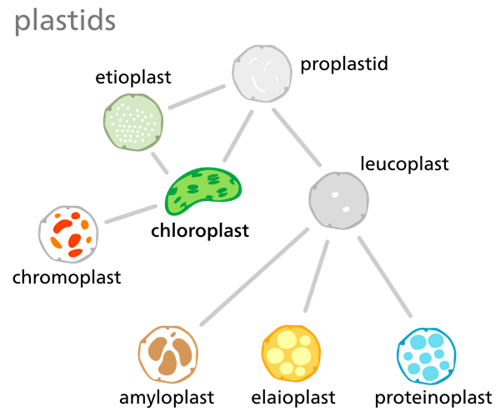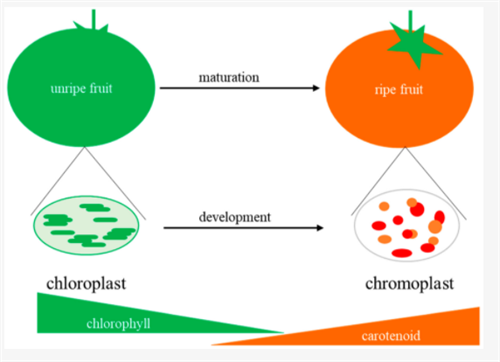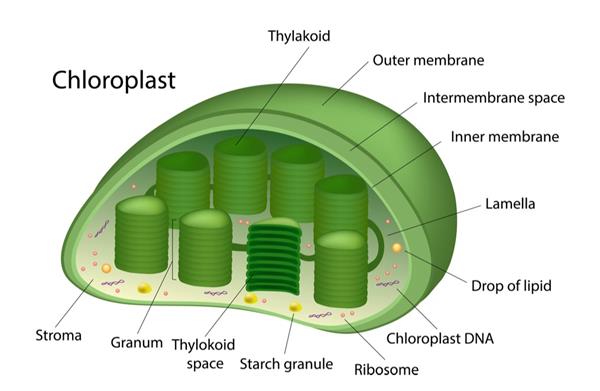
PUMPA - SMART LEARNING
எங்கள் ஆசிரியர்களுடன் 1-ஆன்-1 ஆலோசனை நேரத்தைப் பெறுங்கள். டாப்பர் ஆவதற்கு நாங்கள் பயிற்சி அளிப்போம்
Book Free DemoHave you wondered how the plants get the different colours? Do you know there is a relation between the plant’s green colour and photosynthesis, a process by which plant produce its food? A cell organelle called plastid is responsible for the different colours of the plant and facilitates photosynthesis.
Discovery of plastids: Ernst Haeckelcoined the term plastid in the year \(1866\). Plastids are only found in plant cells. They are absent in animal cell.
Plastids are of three main types depending upon their colour.
1. Chromoplast
2. Leucoplast
1. Chromoplast
2. Leucoplast
3. Chloroplast

Chromoplasts
"Chromo" comes from the Greek word meaning colour.
They are coloured plastids. The colour varies from red, orange, and yellow due to carotenoids presence, which is abundantly found in flowers and fruits.
They are coloured plastids. The colour varies from red, orange, and yellow due to carotenoids presence, which is abundantly found in flowers and fruits.

Function:
They are rich in carotenoids pigments and lipids, which provide colouration to the organs for attracting pollinators.
Pollinators include birds, bats, butterflies, moths, flies, and bees. They used to go to flowers to drink nectar or eat pollen, while pollen grains were being transported around.
Pollinators include birds, bats, butterflies, moths, flies, and bees. They used to go to flowers to drink nectar or eat pollen, while pollen grains were being transported around.
Leucoplasts
Leucoplasts are colourless plastids. They are found in storage cells of roots, seeds and underground stems.
Function: They are responsible for the storage of food.
Leucoplasts are classified into three types based on their storage products.
Amyloplasts stores starch. The term "Amylo" means starch.
Aleuroplasts stores protein. The term "Aleuro" means flour.
Elaioplasts stores oil and fat. The name "Elaiov" is a Greek word for olive.
Chloroplast
These are the plastids containing chlorophyll (a green pigment). They give green colour to the plant and are mostly found in leaves. Chloroplast also contain various yellow or orange pigments in addition to chlorophyll.

Structure: It has various shapes. They may plate-like (Ulothrix), cup-shaped (Chlamydomonas), ribbon-like (Spirogyra).
Stroma: The internal organization of plastids contains several membrane layers embedded in a material called the stroma or matrix. It is a semi- fluid colloidal complex containing DNA, ribosomes and enzymes.
Grana: They are stacks of membrane-bound, flattened sacs containing the molecules of chlorophyll. One thylakoid stack is known as granum. Each thylakoid have chlorophyll on their surface that trap sunlight and take part in the process of photosynthesis.
Important!
Note: The external structure of plastids are similar to mitochondria. They are double-layered, being a semi-autonomous organelle (like mitochondria) they have DNA and ribosomes.
Function: Chlorophyll traps the solar energy, which is used for manufacturing food. These are essential for photosynthesis. So, chloroplasts are called as " kitchen of the cells".
Endosymbiotic theory:
Previously in the mitochondria topic, it was mentioned that the answer to the question about the formation of mitochondria inside a cell will be discussed in the topic of plastid.
Actually formation of plastid and mitochondria inside a cell can be explained by the theory called as endosymbiotic theory.
The word 'symbiosis' means association of two species in which at least one organism benefits because of the other.
Endosymbiotic theory states that some of the cell organelles inside the eukaryotic cells were once prokaryotic organisms.
This theory explains that mitochondria and plastids were once prokaryotic organisms that lived inside the eukaryotic cells through a symbiotic relationship. And, over several million years, they evolved along with the cell as mitochondria and plastids. They both have DNA within their membranes, just like an individual cell, and hence they are called semi-autonomous organelles.
This theory suggests that mitochondria could have formed from aerobic bacteria and plastids from photosynthetic bacteria.
This theory explains that mitochondria and plastids were once prokaryotic organisms that lived inside the eukaryotic cells through a symbiotic relationship. And, over several million years, they evolved along with the cell as mitochondria and plastids. They both have DNA within their membranes, just like an individual cell, and hence they are called semi-autonomous organelles.
This theory suggests that mitochondria could have formed from aerobic bacteria and plastids from photosynthetic bacteria.
Reference:
https://www.freepik.com/free-vector/diagram-showing-process-photosynthesis-with-plant-cells_7442302.
https://www.mdpi.com/1422-0067/21/18/6951/.
https://www.mdpi.com/1422-0067/21/18/6951/.